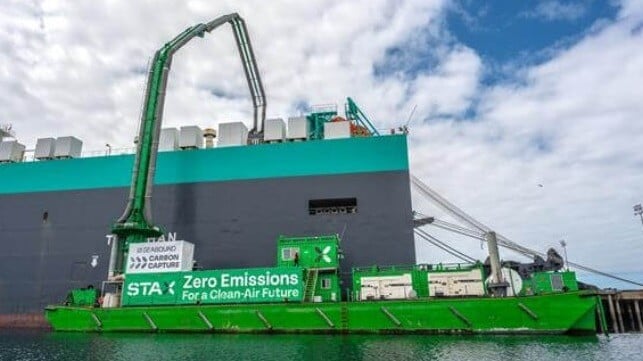UK Funds Project to Combine Carbon and Emission Capture in Southampton

The UK is supporting the next step in emission capture systems that can be deployed in ports as a cost-effective means of reducing emissions. The new project will combine the emissions capture capabilities of STAX Engineering with the carbon capture technology of Seabound.
The project, which also involves Associated British Ports, is receiving an award of £1.1 million ($1.48 million) as a grant under the UK Government’s Clean Maritime Demonstration Competition. They were selected as one of the recipients in the recently completed Round 6 of the competition.
“This project is a breakthrough moment for ports and for the maritime decarbonization landscape,” said Stylianos Papageorgiou, Managing Director of lomarlabs, a maritime venture lab which is also supporting Seabound’s expansion. “By integrating carbon and emissions capture in a scalable, barge-based system, we’re unlocking a practical path to cleaner port operations without retrofitting ships.”
The new project will be the first opportunity to integrate the two technologies and deploy them at the Port of Southampton. The companies had previously announced their plan to deploy three emission capture barges in collaboration with ABP, and will now expand the effort with the integration of carbon capture technology.
STAX launched its operation in California and won the recognition of the California Air Resources Board as the state moved to stop in-port emissions from docked vessels. STAX’s uses barges that are placed alongside the ship and cap the funnel, capturing emissions. It removes up to 99 percent of particulate matter and 95 percent of nitrogen oxides.
Seabound’s modular carbon capture units, sized to match standard 20-foot containers, will be integrated onto STAX’s barge-based emissions capture and control system. The purified gas coming from the STAX system will then flow into Seabound’s compact capture unit, which isolates and stores up to 95 percent of carbon dioxide and 98 percent of sulfur (SO?), before releasing cleaned exhaust.
The project positions Southampton as the first UK port to host a fully-integrated solution that captures both CO2 emissions and criteria pollutants, including sulfur oxides (SO?) and nitrogen oxides (NO?), while ships are docked. The companies assert that the solution provides maritime operators with an immediate, practical path to meet tightening environmental regulations and decarbonization requirements without requiring vessels or ports to undergo retrofits and costly structural changes.
ABP, as the largest port operator in the UK, is supporting efforts to advance the new technologies. In 2024, the company launched its Energy Ventures Accelerator program to aid a variety of early-stage clean energy innovators. In addition to providing support to STAX and Seabound, other initiatives supported by the accelerator include the UK’s first investment in shore power facilities at scale being developed for the Port of Southampton.
For Seabound, this is its second award from the UK Clean Maritime Demonstration Competition. It received support in Round 3 for the demonstration of its carbon capture technology on an in-service vessel. Working with Lomar Shipping and lomarlabs, they demonstrated the system on the Sounion Trader, achieving 78 percent CO2 capture efficiency and over 90 percent SO2 removal. Lomar Shipping plans to deploy its carbon capture solution across the company’s fleet.
